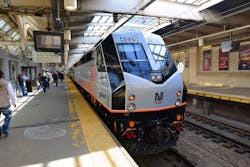Can one of the Largest Mass Transit Microgrids in the US run on Mostly Renewables and Storage?
Renewable energy microgrids are increasingly being tested to serve large-scale operations, including communities. And now a new report makes the case for operating the nation’s third largest transit system largely on renewables.
The report stems from a push by environmental groups over the last several years to block plans for a 140-MW gas-fired microgrid for NJ Transit, a bus and rail system that serves 5,325 square miles in New Jersey.
In early 2021, environmentalists won a victory when NJ Transit withdrew the air permit application that would have allowed the microgrid to be powered solely with natural gas.
Later that year, NJ Transit issued a request for proposals (RFP) to a short-listed group of microgrid developers seeking designs to build and operate the microgrid. The RFP stated that the winning bid must align with the state's goal of achieving 100% carbon-neutral electricity by 2050.
Proposed in response to Super Storm Sandy in 2012, the $577 million microgrid would be built in Kearny, New Jersey, and serve a key portion of the rail system between New York City and northern New Jersey.
It remains to be seen who the bid winner will be and what form of power the microgrid design will use. The RFP anticipates that a contract will be awarded in June and the project will be in operation by August 2028.
Report calls for hybrid microgrid
Given the uncertainty about the final form the microgrid will take, Enpower NJ and Clean Energy Group commissioned Strategen Consulting to evaluate how a hybrid microgrid would perform. Hybrid microgrids use a combination of renewable and fossil fuel resources.
Issued this month, the report concluded that the most cost-effective and environmentally sound configuration would be 97 MW of solar, 76 MW of four-hour battery storage and a 32 MW backup gas turbine.
The hybrid microgrid would provide $328-$376 million more in future value than a microgrid fueled solely with natural gas, according to the report. The figure was derived by calculating avoided environmental costs and market profits achieved by using renewable energy rather than natural gas through 2050.
Diverse revenue streams
The diverse power sources within the hybrid microgrid would give it a financial edge, according to the report, because it is less subject to natural gas price volatility and has more flexibility in leveraging wholesale power markets.
“The components of the alternative renewable energy-based hybrid microgrid system have the advantage of diverse revenue streams. The energy produced by the 97 MW solar portion of the system can provide power to the grid during normal days, while the energy storage system can provide solar integration, energy arbitrage, and ancillary services in the form of synchronized reserves. Both the solar and the storage components can also provide capacity to the PJM market at their respective effective load carrying capability (ELCC) values, and may be eligible to participate in future incentive programs sponsored by the state,” the report said.
Is it reliable?
In the case of a grid outage, the microgrid must be able to serve about 40% of NJ Transit’s normal daily service for two weeks. Could the hybrid microgrid do that?
The report said that the hybrid model passed an hour-by-hour resilience test in three of four load scenarios that took into account solar availability during historic storms that caused power outages.
The report also noted that solar and storage installations have come a long way since the NJ Transit Microgrid was proposed in 2015. That year the US had only six solar plus storage projects installed, with a combined capacity of 96 MW. By comparison, 2021 saw the installation of 70 such systems with a combined capacity of 2,920 MW.
The report defended the hybrid microgrid against other possible clean energy alternatives, such as hydrogen and renewable natural gas (RNG), arguing that future costs and availability of the fuels are uncertain. For example, RNG will only be able to displace 6-15% of natural gas in the US by 2040, according to the report.
Large land requirements
The solar array would require 300-350 acres of land; the report says that NJ Transit has more than 500 acres of land that could be used for the solar panels and even more if the panels are sited near or above rail tracks.
NJ Transit will pay for the microgrid with a $409.8 million grant from the Federal Transit Administration and a 25% match from the state. If the microgrid uses renewable energy and storage, it might also benefit from federal tax incentives available through the Inflation Reduction Act of 2022.
Whether renewables alone can provide the electric reliability required for a complex microgrid remains controversial in the microgrid community. To learn more, view this debate, “The Green Energy Balancing Act,” from Microgrid 2021.
Interested in microgrids? Join us in Anaheim, California May 16-17 for Microgrid 2023: Lights On!
About the Author
Elisa Wood
Editor-in-Chief
Elisa Wood is the editor and founder of EnergyChangemakers.com. She is co-founder and former editor of Microgrid Knowledge.
